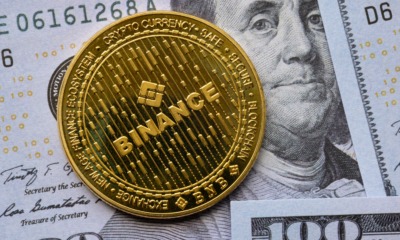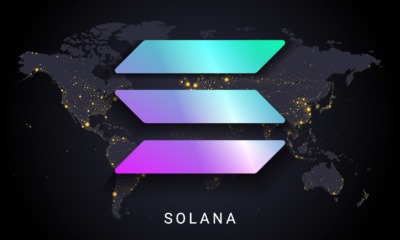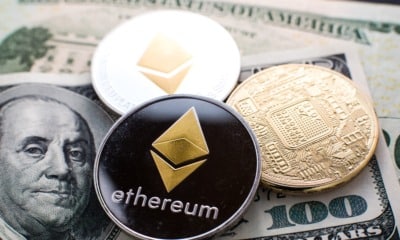Don't Miss
Ideal Base for Stable Cryptocurrency: Comparison of Stablecoins Backed by USD and the Swiss Franc

The ideal cryptocurrency should maintain a stable value relative to fiat money or be subject to insignificant inflation, which will encourage its holders to spend their coins rather than store them. A practical embodiment of this ideal today are stablecoins – cryptocurrencies, the price of which is tied to the value of a real asset, for example, the US dollar.
Stablecoins retain all the main advantages of digital money, such as cryptographic security, decentralization, transparency, accessibility for individuals and legal entities who are entitled on the same terms, while it lacks the main disadvantage – volatility. Therefore, such crypto money is an ideal tool, for example, for the interaction of crypto exchanges with each other, as well as with real exchanges and banks, which still remain suspicious of digital assets. Traders also use stablecoins to record their earnings during periods of high volatility and transfer funds from one exchange platform to another.
Suspicious Tether
The most widespread stablecoin today is Tether (USDT), which price is tied to the US dollar in the ratio 1:1 – that is, 1 USDT can be exchanged for 1 US dollar. The rapid growth to Tether’s volume surpassing 2 billions of these coins, which are now in circulation, showcasing how high the market demand for digital money with a stable value is.
The Tether system is based on blockchain algorithms and works on the Proof of Reserves principle. Theoretically, Tether Limited accounts first receive dollars, then in accordance with the amount of real money, the issue of USDT tokens is conducted. They are sent through crypto exchanges to users who perform transactions between themselves and exchange Tether for other cryptocurrencies. Real dollars at this time are stored on a special account of the company. If the owner of the token decides to cash out, for example, 100 USDT, Tether will send him 100 real dollars and burn 100 tokens. The correspondence between the amount of USDT in the network and the real money in the bank account of Tether Limited is confirmed by a periodic audit.
However, in practice, serious problems arose with this scheme. Since Tether Limited did not bother to conduct regular audits, the cryptocurrency community had a suspicion that the company does not have sufficient reserves to provide all the support for all USDT currently in circulation.
On November 7, 2017, the industry’s media published documents called Paradise Papers, which prove that the Bitfinex Exchange, through which the vast majority of all USDT issues were held, and Tether Limited are managed by the same people. Bitfinex CEO Jan Ludovicus van der Velde occurred the same as CEO of Tether, and Philip Potter holds the position of chief strategist in both companies.
Analysts also noted that Tether issuance process often coincides with the drop in the price of bitcoin: 48.8% of bitcoin growth periods occurred on two-hour intervals after Bitfinex’s wallet were refilled with USDT. The conclusion suggested one: USDT is emitted depending on market conditions, and not the availability of fiat money in reserves.
Therefore, when in January 2018 Tether was issued in the amount of 850 million dollars, market participants began to demand confirmation that USDT is really backed by real dollars. Tether, however, agreed to provide such information to the industry media only on condition that a non-disclosure agreement is signed.
This only further increased the fears of market participants. The conflict broke out with renewed force a couple of months ago: on June 13, a large article was published in the journal of the University of Texas, the authors of which argued that the big jump in the bitcoin price in late 2017 was partly due to the manipulation of the Tether on Bitfinex. The results of this research were widely discussed in leading business media, which made Tether Limited “split”. The company said that it had previously hired a well-known law firm Sporkin & Sullivan (FSS) to audit its activities and bank accounts. On June 18, Tether Limited published a confidential FSS report confirming that the bank accounts of the company had the cash dollars required to provide all the USDT’s available in circulation.
Last week, FSS head FBI ex-director Louis Free gave an interview to Yahoo Finance and confirmed that Tether really kept 2,545 billion dollars in two banks, which covered 2,538 billion coins of Tether in circulation at that time, plus a “safety pillow ” in the amount of about 7 million dollars.
Swiss franc against the dollar
Nevertheless, many market participants did not believe in FSS assessments, since the law firm simply does not have enough qualified specialists in the field of crypto finance. Therefore, the world projects developing new digital money, backed by real assets, started to emerge.
In July, IBM announced the creation of a USD Anchor token, backed by the US dollar. The project is being implemented in cooperation with Stronghold, and the token will be used by Stellar. In Malta, the EURO cryptocurrency was issued, the value of which is tied to the European currency.
ROCKZ AG company is launching a stablecoin backed by the Swiss franc. At first glance, the idea seems rather controversial since the prevalence of this currency in the world is much less than the dollar or the euro. But if it comes to stability, then the Swiss franc simply does not have competitors.
The reliability of this currency is primarily due to the special status of Switzerland itself in the world. This alpine country for many years has served as a model of neutrality, not taking part in wars and international economic conflicts. A high-tech industry, a deficit-free budget, one of the highest per capita GDP in the world combined with low inflation ensure the stability of the Swiss economy.
The highest level of development of banking technologies, including at the level of the Central Bank, allows Swiss financiers to respond quickly to turbulence in the global financial system. A vivid example of this was the multilateral European debt crisis of 2009-2013, when investors, in order to save their money, rushed to buy up the Swiss currency. A huge flow of funds from European countries to Switzerland led to a sharp strengthening of the franc, making Swiss exports less profitable. Therefore, the Swiss National Bank decided to link the franc rate to the euro. But when the European currency began to weaken towards the dollar and affect the franc, on January 15, 2015, the Swiss central bank announced the end of the peg to the euro, which ensured the stability of the Swiss currency against the background of the euro depreciation.
The long-term positive balance of Swiss foreign trade makes large borrowing of money in the international financial market unnecessary. The State Ministry of Finance issues government bonds only to maintain recognition in the global borrowing market. At the same time, the size of the external public debt is purely symbolic, so that the mood of international investors practically does not affect either the economy or the currency of Switzerland. Unsurprisingly, analysts of the banking corporation JPMorgan in July made the Swiss franc in the list of currencies, which, along with the Singapore dollar and the Japanese yen, should be bought in the event of a global recession and economic crisis.
According to economists, over the past fifty years, the US dollar has lost 78% of its value to the Swiss franc. Apparently, in the coming years, this figure will increase significantly. Now, inflation in the US is accelerating oil prices and the trade war, which caused rising prices for steel and aluminum in the US.
At the same time, the demand for the dollar in the world is declining. On the one hand, more and more countries, led by China and Russia, declare the need to abandon the US currency in international settlements. On the other hand, the global demand for US government bonds is falling. The investors, frightened by the dizzying growth of the national debt and the US budget deficit, refuse to invest in Treasury. So, at the auction of the Ministry of Finance of the USA, held in early August on the sale of three-year government bonds, demand was the lowest in ten years – non-residents bought just over 40% of the securities.
All this creates prerequisites for at least a global weakening of the dollar, as a maximum for a new global financial crisis, which economists are increasingly saying that is approaching. In both scenarios, the demand for defensive assets, such as the Swiss franc or the cryptocurrencies tied to it, is growing significantly.
ROCKZ vs. USDT
The economic advantages of the Swiss franc and ROCKZ compared to the US dollar and USDT are complemented by a whole list of other advantages. The first is legal security. Cryptocurrencies that are tightly tied to the US dollar can be recognized as derivatives and, accordingly, fall under the regulation of the US Securities Commission. Since no one thought about it when launching the USDT, Tether holders can have problems with the American regulators at any time.
The Swiss government, on the contrary, has taken a course to provide maximum support to companies associated with crypto and lock-up to become a world leader in this field. Minister of Economy Johann Schneider-Amman recently stated bluntly that Switzerland wants to become a “crypto national nation”. Last year, the Alpine authorities already ranked second after the United States to raise funds through the ICO. Now in Switzerland, there are about 200 companies engaged in the development of blockchain projects.
Until recently, the growth of this industry was hampered by problems with the access of cryptocurrency firms to banking services due to the rules for combating money laundering. However, Heinz Tannler, the financial director of the canton of Zug, recently promised that Swiss politicians and regulators will remove obstacles in coming months, allowing crypto companies to operate with banks in the same way as other companies.
Secondly, ROCKZ itself has several advantages over USDT. In particular, Tether Limited does not exchange USDT for dollars, but only dollars for USDT. Exchanging Tether for the dollar can only be made through the cryptocurrency exchange. If you need to withdraw funds from the exchange when you do not have open positions for trading, then you will probably be given USDT. In this case, the user will have to pay serious commissions if he wants to withdraw his funds in dollars.
ROCKZ, by contrast, does not impose restrictions on the exchange of its cryptocurrency for fiat money. Owners of this coin can transfer the equivalent amount in Swiss francs to their bank account, credit card or receive directly in a Swiss bank. Reserves of Swiss francs supported by ROCKZ coins are deposited in Swiss depositories and banks. Their availability and volume are regularly confirmed by an authoritative auditor without any additional requirements from the holders of the cryptocurrency. All market participants are provided with full and unhindered access to the auditors’ assessments.
Thus, ROCKZ allows all participants of the cryptocurrency market to securely fix positions and be able to quickly enter the cache, be assured of the reliability of the issuer and the security of cryptocurrency in Fiat.
Recently, ROCKZ unexpectedly found another advantage over Tether. Chinese experts on cybersecurity from SlowMist studied the code of the Tether cryptocurrency project and found out something new. This stablecoin has a code vulnerability that allows a double cost error to occur. It turned out that while crypto-instruments are processing the reception of user’s money in USDT, they can erroneously confirm the transfer of money. Such an operation can be recognized as successful, although in fact digital money has not yet been withdrawn from the user’s account. In other words, if you try, in the case of Tether, you can get USDT in your trading account, while actually saving coins.
The total average daily volume of trade in stablecoins for the last four months amounted to almost $ 3 billion, with Tether accounting for more than 99% of this amount. This suggests that more than 99% of the market transactions of market participants were accompanied by a significant risk. The very concept of ROCKZ excludes such a risk and gives investors the opportunity to obtain a more reliable protective tool with a more stable underlying asset.
Disclaimer: This article should not be taken as, and is not intended to provide, investment advice. Global Coin Report and/or its affiliates, employees, writers, and subcontractors are cryptocurrency investors and from time to time may or may not have holdings in some of the coins or tokens they cover. Please conduct your thorough research before investing in any cryptocurrency and read our full disclaimer.
Image courtesy of Pexels
Don't Miss
A Guide to Exploring the Singaporean ETF market

Singapore’s Exchange Traded Fund (ETF) market has grown, offering investors diverse investment opportunities and access to different asset classes. As the market evolves, investors must navigate these uncharted waters with a clear understanding of Singapore’s ETF landscape. This article explores the trends, challenges and strategies for navigating the Singapore ETF market. To start investing in ETFs, you can visit Saxo Capital Markets PTE.
The Singaporean ETF Market: Exponential Growth
The Singapore ETF market has seen significant growth in recent years, with an increasing number of ETFs covering a wide range of asset classes and holders. different investment topics.
One of the notable trends in the Singapore ETF market is the growing diversity of available options. Investors can now choose from ETFs that track domestic and international stock indexes, bonds, commodities, and specialist sectors or themes. This diverse range of ETFs allows investors to create comprehensive portfolios tailored to their investment goals.
The growth of the ETF market in Singapore is also due to growing investor demand for low-cost, transparent, and accessible investment vehicles. ETFs offer benefits such as intraday liquidity, real-time pricing, and the ability to trade on exchanges. These characteristics have made ETFs attractive to retail and institutional investors who want exposure to different asset classes.
Regulatory Landscape and Investor Protection
The Monetary Authority of Singapore (MAS) is the…
Don't Miss
Property Loans for Foreigners in Singapore That You Must Know About

Intending to invest in a residential or commercial property in Singapore?
When it comes to foreigners applying for a loan in Singapore, things can be pretty hard regardless of the reason whether you need the property for personal or business purposes.
In Singapore, buying a property is challenging, whether you are a foreigner or a native, and sometimes applying for a loan is the only way for you to afford it.
HOW MUCH CAN YOU BORROW FOR A PROPERTY LOAN IN SINGAPORE?
As for the Foreigner Loans, in Singapore, there is an exact amount of money you can borrow to finance the purchase of a property.
In this sense, Singapore has the Loan to Value Ratio (LTV).
The LTV ratio is what determines the exact amount of money you can borrow for a property loan, which changes depending on where you try to obtain the loan:
- If you are applying for a bank loan, you can borrow a maximum of 75% of the value of the property you want to purchase. That means if you are looking for a property that costs $500.000, the maximum amount of money a bank lender can give you like a loan in Singapore is going to be $375.000.
- When you are applying for a loan with a Housing…
Don't Miss
CoinField Launches Sologenic Initial Exchange Offering

CoinField has started its Sologenic IEO, which is the first project to utilize the XRP Ledger for tokenizing stocks and ETFs. The sale will last for one week and will officially end on February 25, 2020, before SOLO trading begins on the platform. Sologenic’s native token SOLO is being offered at 0.25 USDT during the IEO.
Earlier this month, Sologenic released the very first decentralized wallet app for SOLO, XRP, and tokenized assets to support the Sologenic ecosystem. The app is available for mobile and desktop via the Apple Store and Google Play. The desktop version is available for Windows and Mac.
“By connecting the traditional financial markets with crypto, Sologenic will bring a significant volume to the crypto markets. The role of the Sologenic ecosystem is to facilitate the trading of a wide range of asset classes such as stocks, ETFs, and precious metals using blockchain technology. Sologenic is an ecosystem where users can tokenize, trade, and spend these digital assets using SOLO cards in real-time. The ultimate goal is to make Sologenic as decentralized as possible, where CoinField’s role will be only limited to KYC and fiat ON & OFF ramping,” said CoinField’s CEO…
-

 Blogs6 years ago
Blogs6 years agoBitcoin Cash (BCH) and Ripple (XRP) Headed to Expansion with Revolut
-

 Blogs6 years ago
Blogs6 years agoAnother Bank Joins Ripple! The first ever bank in Oman to be a part of RippleNet
-

 Blogs6 years ago
Blogs6 years agoStandard Chartered Plans on Extending the Use of Ripple (XRP) Network
-

 Blogs6 years ago
Blogs6 years agoElectroneum (ETN) New Mining App Set For Mass Adoption
-

 Don't Miss6 years ago
Don't Miss6 years agoRipple’s five new partnerships are mouthwatering
-

 Blogs6 years ago
Blogs6 years agoEthereum Classic (ETC) Is Aiming To Align With Ethereum (ETH)
-

 Blogs6 years ago
Blogs6 years agoCryptocurrency is paving new avenues for content creators to explore
-

 Blogs6 years ago
Blogs6 years agoLitecoin (LTC) Becomes Compatible with Blocknet while Getting Listed on Gemini Exchange














